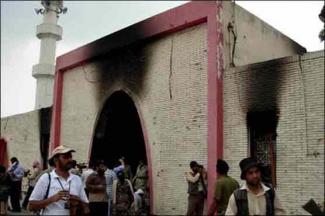Pakistan: The Rise and Fall of Red Mosque
The fall of the Red Mosque (Lal Masjid) has indeed heralded a new era in Pakistan marked by conflict between moderate and fundamentalist forces.
The Mosque, which housed two seminaries (Jamia Hafsa and Jamia Faridia), had been used for Jihadi training during the Cold War period. The Mosque premises became a famous Islamic learning centre for thousands of Muslim students across the region. Its chief, Cleric Maulana Abdullah, was killed in a sectarian clash outside the Mosque in 1998. Following this, Abdullah Aziz and Abdul Rashid Ghazi took over the reins of the establishment from their slain father. Both brothers courted controversy in 2004 when Aziz issued a religious decree against the Pakistani soldiers fighting in Waziristan against the Taliban and Al Qaeda militants, while Abdul Ghazi led anti-Musharraf and anti-US protests in Islamabad.
However, the real crises erupted early this year when the Islamabad administration started the demolition of parts of the mosque, citing illegal construction. This led to protests by the female students that prevented the authorities from continuing with the demolition and, instead, capturing the Children’s Library. In April 2007, the Taliban-style Shariah Court set by Abdul Aziz pronounced a Fatwa against the Tourism Minister Nilofar Bakhtiar for embracing a parachute instructor. The students of Lal Masjid kidnapped government officials, too—former Prime Minister Ch. Shujaat tried to clinch a peace deal between the seminaries of Lal Masjid and the Pakistan government, but it did not reach an amicable settlement.
The primary precursor to the operation of Lal Masjid was the kidnapping of nine Chinese officials from a Chinese health centre. After pressure from the Pakistani officials, the kidnapped Chinese were released. The Federal Interior Minister, Aftab Ahmad Khan Sherpao, visited China and got a stern warning from the Chinese Minister of Public Security, Zhou Yongkang Zhou, to protect the Chinese nationals from working in Pakistan.
The final boil on the Lal Masjid came on July 3 when an armed confrontation ensued between the radical elements and Pakistani Rangers. Around 12,000 students had surrendered as the security forces encircled the mosque and offered amnesty for militants who were ready to lay down arms. Amid the events unfolding, the Pakistan forces caught Maulana Abdul Aziz, the chief cleric of Lal Masjid, trying to flee the Mosque.
Though there were efforts to defuse the tensions through talks with Abdul Ghazi, who was calling the shots from inside the Mosque with the support of foreign militants, they failed without any headway. The impasse led to an immediate storming of the Mosque complex by the Pakistan Army's elite Special Services Group members. The weeklong Operation Silence, as it was code-named, reportedly claimed as many as 400 lives (unofficial estimate), including 12 military personnel.
Indeed, Operation Silence would be instrumental in checking the rise of unstructured extremism in Pakistan that is now hidden inside Mosques and Seminaries located around Lahore, Karachi and North West Frontier Province. The buzz in the military establishment now is to disband the military-mullah alliance, which has been the cardinal project since the 1980s. The post-Cold War climate has undergone a major change, and now there is no need for jihadis or radical Islamists to further the security agenda.
Undoubtedly, Musharraf's brand equity has increased manifold. The day the Pakistan army entered the besieged Mosque, world leaders appreciated Musharraf’s decision. It is almost certain that more financial support for Pakistan is forthcoming.
One would wild guess that Musharraf might impose an emergency rule to get a grip on things if the present situation goes out of control. But this would again complicate the political landscape of the country and bring more problems for Musharraf.
Apprehensions and speculations notwithstanding, the fall of Red Mosque brought the most dreaded fallout, increasing suicide attacks and bomb blasts in tribal-dominated areas like FATA and NWFP areas. There were at least ten suicide attacks in Pakistan following the fall of Red Mosque, including three on July 19. Observers have rightly pointed out that the next zone of crisis in Pakistan would be Waziristan and areas bordering Afghanistan due to the concentration of Taliban and pro-Taliban elements in these areas.
